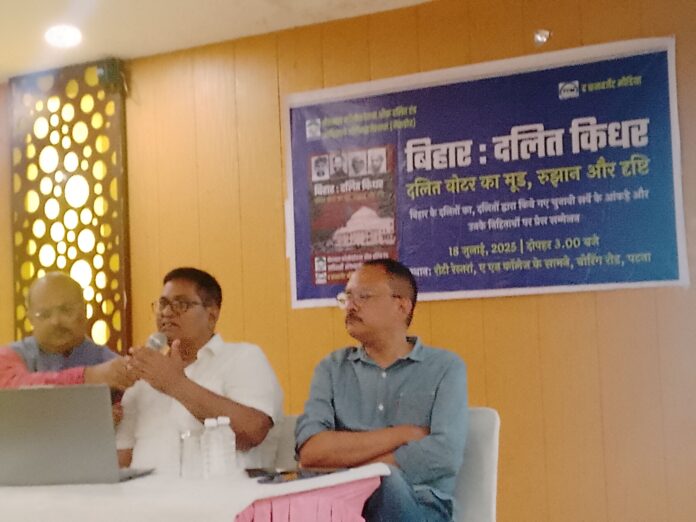Sami Ahmad, TwoCircles.net
Patna: A new survey has revealed a major shift in Bihar’s Dalit political landscape, with the Mahagathbandhan (the RJD, Congress and Left alliance) emerging as the top choice among Dalit voters, securing 46.13% support – well ahead of the NDA’s 31.93%.
Conducted by the National Confederation of Dalit and Adivasi Organisations (NACDAOR) and The Convergent Media (TCM), the survey covered 18,581 respondents across 49 Assembly constituencies, including 11 reserved for Scheduled Castes (SC). The fieldwork spanned from June 10 to July 4, 2025, across Kosi, Mithilanchal, Seemanchal, Bhojpur, Champarana and Magadh-Patliputra regions. The findings were released in Patna on July 18.
The Mahagathbandhan’s dominance is especially notable in Kosi, where support peaks at 72.33%, and in Bhojpur, with 53.75%. The NDA maintains a lead only in Seemanchal, where it secures 42.57% of Dalit votes. The survey points to a growing alignment of Dalits with the Mahagathbandhan’s stance on issues such as unemployment and caste census. A combined 58.38% of respondents credited Rahul Gandhi (30.81%) and Tejashwi Yadav (27.57%) for leading the push on these concerns.
The data suggests a rise in youth-led leadership and issue-based voting patterns, reflecting growing political assertion among Dalits. According to the survey, unemployment, voter list-related anxieties and demands for expanded reservations are key issues that political parties must address to engage this critical voter segment.
RJD leader Tejashwi Yadav’s popularity appears to be growing within the community, particularly for his stance on caste census and unemployment, issues that 58.85% of respondents identified as their top concerns. The caste-based survey in Bihar was carried out when he served as the deputy chief minister, under a government led by Nitish Kumar with support from Lalu Prasad Yadav’s RJD.
Despite Tejashwi’s surge, Prime Minister Narendra Modi continues to hold the top spot in popularity among Dalit voters, with 47.51% support. Congress leader Rahul Gandhi follows closely at 40.30%, which the survey views as a notable gain for the Congress, given its limited organisational presence in the state.
The caste census debate remains central in Bihar politics, and the survey’s findings offer surprising insights into public sentiment. A striking 58.38% of respondents attributed credit for advocating the caste survey to Rahul and Tejashwi – compared to only 33.15% for Prime Minister Modi.
Tejashwi also leads in overall popularity among Dalit leaders, with 28.83% support, followed by Chirag Paswan (25.88%) and Nitish Kumar (22.80%). His support is especially strong among younger Dalits and in regions like Kosi and Bhojpur, pointing to a generational and regional shift toward new leadership.
By contrast, Janata Dal (United) or JD(U) President and Chief Minister Nitish Kumar appears to be losing support among Dalits, particularly among Mahadalit communities. The Dusadh caste shows the least backing at 18.79% and other Mahadalit groups range between 20% and 33% support.
Discontent with Nitish’s government is reflected in the 48.43% of respondents who rated his administration negatively. Disapproval is highest in Bhojpur (71.10%) and Kosi (68.75%). While some communities like Mehtar, Hadi, Valmiki and Pasi expressed relatively better views, the overall mood indicates declining trust in his leadership.
Unemployment remains the dominant concern for Dalits, cited by 58.85% of respondents, with the crisis felt most deeply in Kosi (80.51%) and Bhojpur (61.42%). Education and healthcare (14.67%), along with corruption (11.21%), were also highlighted as significant issues.
The survey also examined Dalit perceptions of the ongoing and controversial Special Intensive Revision (SIR) of the voter list. Only 51.22% of respondents said they trust the Election Commission of India, while 27.40% raised doubts about its impartiality. A concerning 71.56% feared being removed from the voter rolls, especially among Ravidas (83.05%), Pasis (78.84%) and in regions like Seemanchal (78.08%) and Kosi (77.19%).
In terms of legacy, Ram Vilas Paswan continues to be the most influential Dalit leader overall, with 52.35% support, especially among Dusadhs (65.37%) and smaller castes (68.36%). Among Ravidas, Babu Jagjivan Ram remains the most admired, with 47.87% support.
Conducted entirely by Dalit activists and covering all 23 Dalit sub-castes, the survey had strong representation from Dusadhs (31%), Ravidas (30.72%) and Musahars (17.08%), together accounting for 97.8% of Bihar’s Dalit population. Four training workshops were held in Patna, Begusarai and Darbhanga to ensure methodical and community-rooted data collection.
The findings point to a major shift in Bihar’s Dalit political sentiment, indicating growing alignment with Mahagathbandhan and Tejashwi Yadav and a decline in Nitish Kumar’s influence, particularly among Mahadalits. Issue-based politics, especially focussed on unemployment and caste representation, appear to be driving the change.
NACDAOR Chairman Ashok Bharti and TCM Directors Prem Kumar and Ranjan Kumar hailed the study as a milestone in participatory research. They emphasised its importance in capturing the real concerns of Dalit communities. The 25-day fieldwork, backed by four intensive residential workshops, ensured methodological accuracy and deep grassroots insight – making this a significant intervention in the run-up to Bihar’s Assembly elections in October–November.


